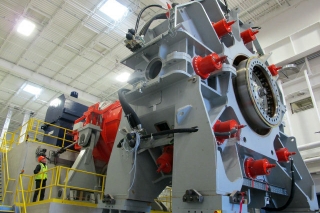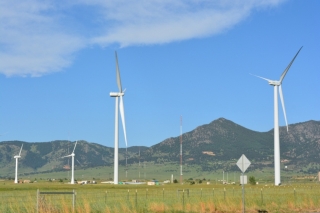
The Wind Program works with industry partners to increase the performance and reliability of next-generation wind technologies while lowering the cost of wind energy. The program's research efforts have helped to increase the average capacity factor (a measure of power plant productivity) from 22% for wind turbines installed before 1998 to 32% for turbines installed between 2006 and 2013. .
To ensure future industry growth, the technology must continue to evolve, building on earlier successes to further improve reliability, increase capacity factors, and reduce costs. This page describes the goal of the program's large wind technology research efforts and highlights some of its recent projects.
Research Project Highlights
These are some of the key research project highlights from the program's next-generation wind technology research. From 2006 to 2014, the Wind Program provided awards totaling more than $160 million for projects focused on testing, manufacturing, and component development.
Prototype Development
Modern wind turbines are increasingly cost-effective and more reliable, and have scaled up in size to multi-megawatt power ratings. Since 1999, the average turbine generating capacity has increased, with turbines installed in 2013 averaging 1.87 MW of capacity. Wind Program research has helped facilitate this transition, through the development of longer, lighter rotor blades, taller towers, more reliable drivetrains, and performance-optimizing control systems. Furthermore, improved turbine performance has led to a more robust domestic wind industry that saw wind turbine technology exports grow from $16 million in 2007 to $500 million in 2013.
During the past two decades, the program has worked with industry to develop a number of prototype technologies, many of which have become commercially viable products. One example is the GE Wind Energy 1.5-megawatt (MW) wind turbine. Since the early 1990s, the program worked with GE and its predecessors to test components such as blades, generators, and control systems on generations of turbine designs that led to GE's 1.5-MW model. The GE 1.5 constitutes approximately half of the nation’s installed commercial wind energy fleet, and is a major competitor in global markets.

Component Development
The program works with industry partners to improve the performance and reliability of system components. Knight and Carver's Wind Blade Division in National City, California, worked with researchers at the Department of Energy'sSandia National Laboratories to develop an innovative wind turbine blade that has led to an increase in energy capture by 12% The most distinctive characteristic of the Sweep Twist Adaptive Rotor (STAR) blade is a gently curved tip, which, unlike the vast majority of blades in use, is specially designed to take maximum advantage of all wind speeds, including slower speeds.
To support the development of more reliable gearboxes, the program has worked with several companies to design and test innovative drivetrain concepts. Through the support of $47 million in DOE funding, the nation’s largest and one of the world’s most advanced wind energy testing facilities was opened at Clemson University to help speed the deployment of next generation energy technology, reduce costs for manufacturers and boost global competitiveness for American companies. The Clemson facility is equipped with two testing bays – for up to 7.5-megawatt and 15-megawatt drivetrains, respectively. The Clemson facility also features a grid simulator that mimics real-world conditions, helping researchers better study the interactions between wind energy technologies and the U.S. power grid.
Utility-Scale Research Turbine
In 2009, the program installed a GE 1.5-MW wind turbine at the National Wind Technology Center (NWTC) located on the National Renewable Energy Laboratory campus in Boulder, Colorado. This turbine was the first large-scale wind turbine fully owned by DOE and serves as a platform for research projects aimed at improving the performance of wind technology and lowering the costs of wind energy. The NWTC is now collaborating with Siemens Energy to conduct aerodynamic field experiments on a 2.3-MW wind turbine. These experiments utilize sonic as well as conventional anemometers and wind vanes on the NWTC's 135 meter meteorological tower to measure characteristics such as inflow, turbine response, and wind wake. The data gained from these experiments will provide new insights into multi-megawatt turbine aerodynamic response, structural loading, power production, and fatigue life that can be used to increase reliability and performance. The research being done at the NWTC complements DOE's Atmosphere to Electrons (A2e) initiative that targets significant reductions in the cost of wind energy through an improved understanding of the complex physics governing wind flow into and through wind farms.

Text Version
International Collaboration
As a member of the International Energy Agency (IEA) Wind Energy Executive Committee, the program supports international wind energy research efforts by participating in 12 areas of wind energy research. The program's participation in these international research efforts provides U.S. researchers an opportunity to collaborate with international experts in wind energy, exchange recent technical and market information, and gain valuable feedback for the U.S. industry. For more information on IEA activities, visit the International Energy Agency Web site.
http://energy.gov/eere/next-generation-wind-technology















